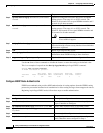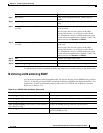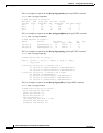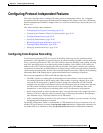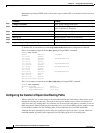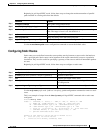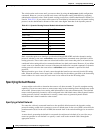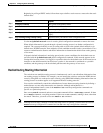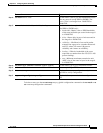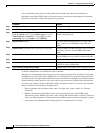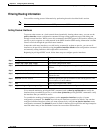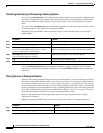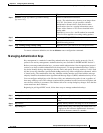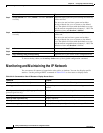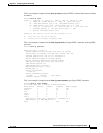
22-58
Catalyst 3550 Multilayer Switch Software Configuration Guide
78-11194-03
Chapter 22 Configuring IP Unicast Routing
Configuring Protocol-Independent Features
Beginning in privileged EXEC mode, follow these steps to configure a route map for redistribution:
Command Purpose
Step 1
configure terminal Enter global configuration mode.
Step 2
route-map map-tag [permit | deny] [sequence number] Define any route maps used to control redistribution
and enter route-map configuration mode.
map-tag—A meaningful name for the route map.
The redistribute router configuration command
uses this name to reference this route map. Multiple
route maps might share the same map tag name.
(Optional) If permit is specified and the match
criteria are met for this route map, the route is
redistributed as controlled by the set actions. If deny
is specified, the route is not redistributed.
sequence number (Optional)— Number that
indicates the position a new route map is to have in
the list of route maps already configured with the
same name.
Step 3
match ip address {access-list-number | access-list-name}
[...access-list-number | ...access-list-name]
Match a standard access list by specifying the name
or number. It can be an integer from 1 to 199.
Step 4
match metric metric-value Match the specified route metric. The metric-value
can be an IGRP five-part metric with a specified
value from 0 to 4294967295.
Step 5
match ip next-hop {access-list-number | access-list-name}
[...access-list-number | ...access-list-name]
Match a next-hop router address passed by one of
the access lists specified (numbered from 1 to 199).
Step 6
match tag tag value [...tag-value] Match the specified tag value in a list of one or more
route tag values. Each can be an integer from 0 to
4294967295.
Step 7
match interface type number [...type number] Match the specified next hop route out one of the
specified interfaces.
Step 8
match ip route-source {access-list-number |
access-list-name} [...access-list-number | ...access-list-name]
Match the address specified by the specified
advertised access lists.
Step 9
match route-type {local | internal | external [type-1 |
type-2] | level-1 | level-2}
Match the specified route-type:
• local—Locally generated BGP routes.
• internal—OSPF intra-area and interarea routes
or EIGRP internal routes.
• external—OSPF external routes (Type 1 or
Type 2) or EIGRP external routes.
• level-1 | -2—IS-IS Level 1 or Level 2 routes.
Step 10
set next-hop next-hop Specify the address of the next hop.
Step 11
set level {level-1 | level-2 | level-1-2 | stub-area | backbone} Set the level for routes that are advertised into the
specified area of the routing domain. The stub-area
and backbone are OSPF NSSA and backbone areas.



